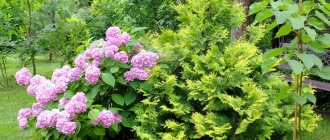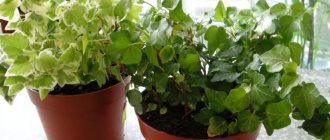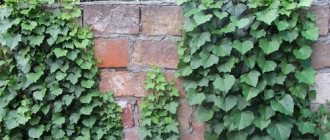You can grow boxwood at home in a pot with the same ease as in open ground, despite the fact that this evergreen plant is traditionally used to create garden design. Perennial bushes with thick, lush green foliage decorate not only window sills, but also closed loggias or open terraces and verandas. Growing boxwood in pots or tubs is sometimes even easier than in the garden. However, in order for the plant to develop well and grow quickly, it is necessary to choose varieties suitable for the home, follow the planting algorithm, temperature conditions, rules of care, pruning and watering.
The culture grows well in pots
Is it possible to grow boxwood in an apartment?
An unpretentious boxwood on a balcony or in an apartment, grown in a pot or tub, will feel no worse than in the garden. It serves as a decoration for the interior of the house, does not require special attention, and also perfectly purifies the air in the room.
Important! Greenery and shrub bark contain toxic substances that can harm animals and small children, so pots should be placed in a safe place at home.
Indoor varieties of boxwood rarely grow more than 1 m in height, and most reach only 30-60 cm. Compact bushes with straight branches, on which dense, pairwise leaves sit, grown at home do not bloom. Otherwise, home plantings are no different from garden varieties, and from their crowns you can form various shapes and even grow a bonsai.
Boxwood and its role in landscaping your home
The life of a modern person mainly passes among urban concrete landscapes, surrounded by dead objects and mechanisms. Therefore, it is not surprising that people feel an urgent need to introduce elements of living nature into the surrounding space. This is clearly expressed in modern interior and exterior art. Many designers consider living plants to be the best decoration for homes and adjacent areas. The matter is no longer limited to flowers in ceramic pots or traditional flower beds. Living greenery becomes a material in designer fantasies, taking on amazing forms - from exquisite borders, hedges, picturesque parterres, green arches and arbors to topiary sculptures. One of the favorite plants among designers who design parks and courtyards, winter gardens and apartments is boxwood.
Features of growing boxwood in a pot
A houseplant, boxwood, growing at home, has some special features for caring for itself, unlike a garden plant. In order for the bush to be beautiful and have a decorative appearance at home, the following points should be taken into account:
- boxwood needs to be provided with good lighting, so you need to place pots on window sills in the south and southeast side of the house;
- the plant loves fresh air, and if the room is not regularly ventilated, it will wither and develop poorly;
- The evergreen shrub requires high humidity, so you must remember to spray the leaves every day.
Important! Boxwood should be irrigated not only in hot summer, but also in winter, because hot radiators dry out the air in the room.
Boxwood propagation and seedling care
In natural habitats, boxwood reproduces both vegetatively and by seeds formed in fruit boxes and literally shooting out several meters after ripening.
To speed up the process and make it easier to care for, boxwood propagation at home is carried out using cuttings. You can get cuttings twice a year.
- In the summer months, young shoots that have recently become woody at the base are cut off for planting. In most cases, such cuttings can be obtained in June and July.
- In the last days of summer or at the beginning of September, you can also cut cuttings up to 10 cm long, containing 2-3 internodes.
Planting material is planted under film in a moist mixture of peat and garden soil.
At home, boxwood can also be propagated by layering obtained from young shoots inclined towards the soil.
On such a branch, a cut of bark is made with a fragment of wood and the shoot is pressed to the ground, securing this position with a wire bracket and directing the upper part of the layer vertically. Rooting of boxwood can take up to three weeks. You can speed up the process with the help of growth stimulants, regular watering and slight heating of the soil. When the young plants take root, they are planted at a distance of 10 cm from each other or in separate small pots.
Types and varieties of boxwood for growing at home
When choosing boxwood for your home, it is better to pay attention to low-growing species that form compact bushes. They will not take up much space on the windowsill, balcony or loggia, even when they reach their maximum size. The following varieties of boxwood are considered the most popular for the home:
- Compacta (buxus microphylla Compacta) is a dwarf bush with a very dense, rounded crown. Annual growth is 3-4 cm in height, the same in width;
- Marginata (Buxus sempervirens Marginata) - grows up to 1 m in height in indoor conditions, therefore it is well suited for tub growing. It has a very decorative appearance due to the color of the leaves, which have a lighter border along the edge;
- Boxwood Aureovariegata is also a very decorative compact bush, characterized by the yellow-green color of slightly oblong leaves.
You should not try to grow garden varieties of boxwood at home. They require different care, temperature conditions and air humidity. Therefore, garden bushes in an apartment quickly lose their foliage and attractive appearance, unlike dwarf varieties and hybrids that retain their beauty all year round.
Boxwood at home is an evergreen plant))) + LOTS OF LINKS ON HOUSE PLANTS.
Boxwood is a favorite plant of gardeners, who use it as a hedge. The evergreen fence turns out to be so dense and dense that it looks like a real wall. It’s not for nothing that boxwood (Buxus) means dense in Greek. From the crown you can form a wide variety of geometric, and not only, shapes.
But, more recently, boxwood began to be grown as a houseplant. In general, I like miniature compositions so that they fit on the windowsill; the apartment is not rubber. And boxwood grows very slowly, about 5 cm per year with good care, and therefore does not take up much space.
Three species take root best in indoor conditions: small-leaved (Buxus microphylla) with leaf lengths from 0.5 to 2.5 cm; bolearic with larger leaves up to 4.5 cm; and the most common is evergreen (B. sempervirens) with leaves 3 cm long. They are most adapted to the limited space of a container.
Be careful when growing boxwood at home: it is quite demanding; if there are mistakes in care, it will shed its leaves. The most suitable place for boxwood is a windowsill with access to direct but soft sunlight. It also grows well in dimly lit places, but then it will look less decorative.
Keep temperatures moderate, and be sure to provide cool conditions in winter.
As for watering, the roots do not tolerate waterlogging, but there is also no need to dry out the soil too much. Alternatively, you can use moss or pebbles on the surface of the soil to keep it from drying out.
It is advisable to spray the leaves regularly; in a room with dry air they dry out and curl. In addition, excessive dryness can lead to the appearance of spider mites and scale insects.
Boxwood is replanted as needed every 2-3 years. Always stick to the following soil composition: 4 parts turf soil, 2 parts leaf soil and 1 part coarse sand.
In spring and summer, it is necessary to feed container boxwood with complex mineral fertilizer. And also expose it to fresh air, protecting it from the hot sun.
When growing boxwood at home, you can shape the crown to your liking: in the form of a ball, cone or cube. Or you can try to form a figurine of some animal, it will be difficult, but it will look impressive.
https://www.topauthor.ru/pochemu_na_uchastke_stoit_visagivat_samshit_505a.html
https://grimuar.ru/primetyi/kakie-derevya-mozhno-sazhat-vozle-doma-primetyi-nashih-predkov.html
https://domsadovnika.ru/%D1%81%D0%B0%D0%BC%D1%88%D0%B8%D1%82-%D0%B8-%D0%B5%D0%B3%D0%BE -%D1%80%D0%BE%D0%BB%D1%8C-%D0%B2-%D0%BE%D0%B7%D0%B5%D0%BB%D0%B5%D0%BD%D0% B5%D0%BD%D0%B8%D0%B8-%D0%B2%D0%B0%D1%88%D0%B5%D0%B3%D0%BE-%D0%B4/
https://irrox.com.ru/samshit-doma-vechnozeljonoe-rastenie-kucha-ssylok-po-komnatnym-rastenijam
Planting boxwood at home
Living plants have always been considered the best interior decoration, be it an office or an ordinary apartment. And although boxwood is relatively unpretentious, it is important for it to provide optimal conditions at home in order to maintain its decorative value.
Boxwood is light-loving and needs fresh air
Also, the appearance of the bushes largely depends on the soil in which they were planted, the correctly chosen pot, the time of planting and a well-organized schedule of watering and fertilizing.
Recommended timing
It is recommended to plant rooted boxwood cuttings in pots for growing at home in early autumn, so that they have time to take root before the onset of winter, when boxwood needs rest. However, indoor species can be planted throughout the year, except during the cold winter months. Young seedlings adapt well to a new place and quickly take root.
Selection of containers
When choosing a container for planting boxwood, you should give preference to classic pots. That is, the height should be slightly larger than the width. The pot must be selected so that the diameter is 2 cm larger than the previous one.
What kind of soil is needed for planting boxwood in a pot?
In the wild, boxwood prefers rocky places with depleted, calcareous and dry soil. Therefore, to plant a house in pots or tubs, you need to mix black soil or garden turf with lime and river sand. The substrate must be nutritious, loose and breathable. You can buy a special mixture or prepare it yourself:
- turf soil – 4 parts;
- leaf soil - 2 parts;
- river sand – 1 part;
- lime - 1 part.
Important! It is not recommended to add peat, humus and compost to the soil mixture.
Landing algorithm
When planting store-bought plants in new containers at home, it is important to try to injure the root system as little as possible. The algorithm is as follows:
- Before transplanting a seedling or adult plant, the soil in the pot must be moistened abundantly so that the earthen ball with the root system can be easily removed.
- The planting container should be three times larger than the earthen lump removed from the previous pot.
- Place drainage (expanded clay, perlite) at the bottom of the new container in a layer of at least 3 cm.
- Place the plant strictly in the center of the planting container and carefully straighten the roots.
- Fill the pot with substrate and tamp lightly.
After planting, boxwood must be watered abundantly so that it takes root faster and takes root better.
How to replant boxwood?
To transplant young seedlings and already mature boxwood bushes, you need a soil mixture with a neutral reaction, consisting of:
- two parts of humus;
- the same amount of sand;
- one part of turf land;
- a small amount of fine charcoal.
If the soil turns out to be too loose, add a little clay to it. This is especially important when planting boxwood intended for bonsai and which subsequently does not need to be replanted for a long time.
All types of boxwood require good drainage from fine gravel or stone chips with coarse sand.
The best time to transplant is spring. During the warm months, the plant will have time to acclimatize, and winter will become less of a challenge for it. The new pot should not be overly large, especially when it comes to replanting an adult bush.
How to replant boxwood with a closed root system, bought in a store? Often, in such plants, the roots grow through the drainage holes, and inside the container they are woven into a tight ball. In this case, such a lump should not be attempted to be straightened or untangled. The roots that have climbed onto the walls of the pot are carefully cut off flush with the bottom, the lump along with the peat soil is removed from the container and carefully transferred into the prepared container and the prepared mixture is added.
How to care for a boxwood houseplant
Caring for boxwood in a pot is not so difficult, however, if you lose sight of some of the subtleties, the decorative appearance of the evergreen bush is quickly lost. Therefore, it is necessary to monitor the slightest changes in the foliage of the bush in order to help in time.
Indoor microclimate
It is important to maintain a constant temperature in the room around +16…+18 °C. If you allow sudden changes or a decrease in humidity, boxwood can shed its foliage.
In summer, the optimal temperature at which the crop will feel good in the house is +23 °C. At higher thermometer readings, frequent ventilation must be provided.
If the foliage of a boxwood growing at home begins to curl and wither, this indicates insufficient humidity in the room. In this case, the bushes should be sprayed several times a day and open containers of water should be placed next to the pots.
Watering and fertilizing schedule
Boxwood should be watered carefully, without over-moistening the soil, but also without allowing prolonged drought. When water stagnates in the roots, putrefactive processes can begin. Therefore, it is recommended to water frequently, but not abundantly, as the top layer of the earthen clod dries out.
Boxwood must be sprayed daily with water at room temperature.
The frequency of watering at home depends on the size of the pot and the plant itself. In winter, watering is reduced to the minimum necessary, while preventing the roots and greens from drying out.
It is necessary to feed a bush growing at home with potassium complex fertilizers from April to August during watering once a week. If the greens acquire a reddish or bronze tint, it is necessary to feed the plant with nitrogen-containing fertilizers.
Trimming
Timely pruning allows you to give the boxwood the desired shape with exquisite and even sometimes fantastic silhouette outlines. Since the bush grows slowly, the achieved configuration of the bush will remain for quite a long time, practically without changing its contours.
The shoots are trimmed throughout the year as they grow, thereby giving the crown the desired shape
The crop tolerates shearing well, so even quite severe pruning of the crown will not harm it. However, you should adhere to the rule - leave at least two leaves on each shoot.
Transfer
Boxwood growing at home is rarely replanted. Usually once every three years (March-April) due to its slow growth. A bonsai formed from boxwood is not recommended to be replanted throughout its life.
When replanting, the transfer method is used, which is the most gentle for the plant’s root system. It is strictly forbidden to destroy or vigorously shake off the earthen lump. It is enough to carefully remove the top layer of the contaminated substrate. Boxwood tolerates the procedure easily and quickly takes root in a new pot.
Wintering boxwood in a pot
During the winter period, it is recommended to place boxwood pots at home in a room with a low temperature (closed balcony, loggia, glazed veranda) - +5... +10°C. Boxwood growing in an apartment must have a period of rest and wintering. If the thermometer readings drop below, the crop will simply die.
If it is not possible to create an optimal temperature at home for wintering boxwood, then pots with bushes should be placed as far as possible from central heating pipes or other heating devices.
Reproduction
You can get new plants in three ways: seeds, cuttings, layering. Growing through seeds will take a long time, so it is recommended to propagate by cuttings or layering.
You may be interested in: Favorable days for planting Ageratum seedlings in 2021 according to the lunar calendar Favorable days for sowing snapdragon seedlings in 2021 according to the lunar sowing calendar Favorable days for sowing lobelia in 2021 according to the lunar sowing calendar
Seeds quickly lose their viability; if possible, they should be planted immediately after ripening. It is recommended to soak the material for a day in Epin or Zircon preparations to accelerate root formation and protect against diseases. Then the seeds are placed between layers of damp gauze and ensure that the gauze is always damp, but not wet. After the sprouts appear, on average a month:
- Sprouted seeds are placed in prepared soil.
- They make a greenhouse - the container is hidden under glass or film.
- Periodically it is necessary to open the greenhouse and ventilate the seedlings to avoid the appearance of mold.
If everything is done correctly, seedlings can be seen in three weeks. When the plants grow and become stronger, they should be planted and kept in a warm, bright room until spring. Standard care. In spring, plant in the ground.
Cuttings are the easiest method, suitable for a beginner. It is better to do this in the spring, but subject to certain conditions, it is allowed at other times of the year. During pruning, select several branches about 10 cm long. Root immediately in the ground. You can put it in water and wait for the branches to take root.
On a note!
When planting directly in the ground, the lower leaves of the cut branches are removed, the cut is treated with Kornevin, they are inserted into a depression in the ground and compacted around it.
Then they water and wait for the cuttings to root, which occurs in about a month. The container with cuttings should not be placed in direct sunlight.
Layering is also not a very difficult way to propagate boxwood. With this method, a side branch is pinned to the ground with a wooden slingshot or wire, sprinkled with earth and waited for rooting.
Diseases and pests
Boxwood, growing at home in a pot, is less susceptible to diseases and pest attacks than garden plants. However, he also has his enemies:
- scale insect;
- spider mite;
- boxwood fire.
To combat parasites, it is enough to regularly inspect the green crown and, at the first sign of infection, treat the foliage with a soapy solution or simply bathe it in the shower. Experienced gardeners do not like to spray shrubs with pesticides, because this destroys not only pests, but also beneficial insects, which are orderlies and successfully destroy parasites on their own. These include the ladybug, predatory mite, lacewing and hoverfly - the worst enemies of boxwood pests. Therefore, if possible, after a shower it is enough to simply take the pot with the affected plant out into the garden.
Boxwood rarely gets sick at home and is often caused by an improperly organized watering schedule and an unsuitable indoor microclimate. This is mainly root rot, which is manifested by weakening shoots and wilting of the leaf mass. If the boxwood sheds its leaves, it will most likely not be possible to restore them.
Boxwood pests
The crop is damaged by pests such as spider mites, scale insects, and butterfly caterpillars. Special industrial preparations are used against parasites.
One of the most malicious pests is the boxwood moth. It causes leaves to yellow and fall off. In a short time, the moth can cause significant damage to greenery.
Fighting methods:
- Carefully cut out all damaged branches and burn them.
- It is good to treat the foliage with anti-moth preparations (Decis, Karate). The processing process is complicated by the very dense crown of the plant.
- The above mentioned manipulations are repeated 2 – 3 more times, with an interval of 10 days.
The following video will tell you how to combat this dangerous pest.
How to propagate indoor boxwood
Indoor boxwoods growing at home are propagated by cuttings, since they do not bloom and seeds cannot be obtained. Suitable for cuttings are young, non-lignified shoots, which are cut in mid-summer or autumn. Spring ones are too tender, so after cutting they may die and not take root.
The length of the cutting must be at least 10 cm
After this, the branches should be placed in a glass of water and a growth stimulant for a day, and then buried in the ground and covered with a bag or film. In a month, roots will appear, and the seedlings can be transplanted into a pot in a permanent place.
Planting in open ground
Boxwood is an undemanding plant that even a novice gardener can handle. The seedling should be chosen that is visually healthy, with leaves of a lush green color, if any. With a powerful root system.
Attention!
The main condition is permeable, moderately moist soil; the crop dies in a wetland. Responsive to nutritional supplements.
Flower growers recommend planting seedlings in the fall until mid-October. But planting is allowed from spring to autumn. It takes root on average in 4 weeks. It is best to plant plants on a cloudy day.
Planting process:
- A day before the intended planting, the seedling needs to be watered abundantly.
- When planting, you need to keep the earthen ball intact so as not to damage the root system.
- A place for planting is prepared in the ground. The hole in the ground should not greatly exceed the volume of the plant's earthen coma.
- The bottom of the recess is lined with drainage material - vermiculite, broken brick, 5 cm thick.
- The seedling is placed straight, the roots are straightened, then carefully covered with soil.
Carefully compact the soil around the seedling and water it with settled water, then mulch it. Re-watering no earlier than seven days later, unless there is rain. Around the seedling it is necessary to make a low embankment of soil with a diameter of 50-70 cm so that water is absorbed into the ground in a strictly limited area.
Boxwood is perfect for decoration:
- borders;
- landscape compositions.
The landing order depends on the objectives being pursued. To obtain a hedge, you need to plant an average of 4-5 seedlings at a distance of 25-30 cm. The bushes should not be planted too close so that they do not interfere with growth and not too far away, as the decorative appearance of the hedge will suffer. To decorate a low border, bushes are planted in a checkerboard pattern, maintaining a distance of 15-20 cm between them.
Features of decorative boxwood
Boxwood is an evergreen shrub that has excellent characteristics as a home or garden ornamental plant, which can be flexibly used in the design of home interiors and country or garden plots.
The plant has a lush deciduous “hair” and tolerates any “haircuts”. Pruned branches and leaves produce active lateral shoots, and the foliage, growing, becomes even thicker and denser.
Features of boxwood
Trimming boxwood leaves allows you to give the bushes any shape that matches your design ideas and imagination. Boxwood is a slow-growing shrub, so it retains its design shape for a long time after being cut. Boxwood is trimmed at any time, regardless of the season.
Boxwood does not bloom often, usually in the spring. Its yellow or greenish flowers are inconspicuous, but have a pleasant honey aroma. The color of the leaves can be green or variegated, hence the main types of boxwood - green and variegated. Green is considered more hardy.
The most common types of boxwood grown at home:
- "Angustifolia", which has narrow, elongated leaves of an elegant shape, with a bluish tint. The bush is elongated and tall. This plant is successfully used to create hedges.
- "Bullata" with wide, dark green, sometimes blue-tinged, round or oval leaves. The bush grows up to two to three meters high and one and a half to two meters wide. When flowering, this variety of boxwood is covered with yellow-lemon delicate flowers with a sharp honey aroma.
- 'Myrtifolia' is a low-growing shrub covered in yellowish-green leaves edged with white.
- "Suffruticosa" is considered a dwarf shrub. Its height, as a rule, does not exceed 80 cm. The shrub is used for borders in flower beds, to create relief patterns, drawings, and inscriptions on lawns.
The unpretentiousness of this plant allows you to equally successfully grow boxwood at home and outdoors. Boxwood takes root well; its reproduction, as well as caring for it, does not require much trouble. It is not afraid of drafts, tolerates dry and rainy periods well, and feels comfortable in open areas and in dense shade. In the wild, this evergreen shrub grows in rocky areas, mainly on calcareous soils. Boxwood does not like waterlogged soil, so water should not stagnate in the soil where this shrub grows. Caring for boxwood is not difficult, since the plant is not capricious. It is not afraid of pests and rarely gets sick.
Homemade boxwood in a pot
The appearance of a plant largely depends on the location in which it is located. A few observations will help you choose the right place for this shrub.
- When growing boxwood indoors, it is best to keep the pots on a sunny windowsill, as the plant loves sunlight. If boxwood grows in the yard, it will feel best in shaded areas.
- The location where boxwood grows affects the color of the foliage. In the shade, boxwood leaves become dark green, in the light they lighten, acquiring a light green tint. In dry times, the leaves may turn yellowish.
Boxwood growing at home should be in a safe place, protected from children, since plant tissues are poisonous. This does not affect the atmosphere of the house or degrade the air quality. Poison can become a health hazard only if it enters the body.











